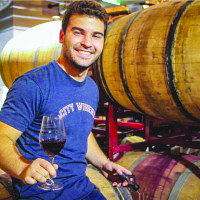A look at alcohol-free wines
According to Richard Jacob, one of the hottest trends in alcohol at the moment is no alcohol. “It’s a really rapidly growing industry,” he said. “There have been a lot of new businesses starting just mainly focused on producing non-alcoholic or zero ABV drinks. It’s really interesting.”
Jacob, who works for Vinilandia NH in Portsmouth, a wine importer specializing in small, estate-grown wines, says the buzz in the industry is that alcohol-free beverages are about to experience a huge growth in the beer and wine markets.
Jacob said, there is a lot of incentive for a beverage producer to make a zero-proof product. “For example,” he said, “Coca-Cola is non-alcoholic at the end of the day, right? It’s just a beverage and all you have to do is, you make it like a craft good beverage, then you can just slap the word non-alcoholic on it and it just becomes something a little special. With that, you don’t have to go through the TTB — the Trade and Tax Bureau or the Fed — as a producer, because you’re not actually producing an alcoholic drink. You’re producing something different, but [that] can be enjoyed in a similar manner. So that way, these businesses don’t have to go through the same kind of circuits that wineries or breweries or distilleries need to go through with the federal government in order to produce their product.”
There are essentially two ways to produce a non-alcoholic beverage, Jacob said. “The big difference in making an alcoholic product and removing the alcohol, and making a product that is just non-alcoholic at all, is an important one.” Because the investment in equipment to remove alcohol from beer or wine is substantial, he said, that is the route followed by big players in the industry. Smaller wineries and breweries generally take the other approach of not fermenting their product in the first place.
Emma Stetson, the owner of Wine on Main in Concord, also sees a growing trend of people looking for complex adult beverages without alcohol. She said that this is most evident after the holidays, when many of her customers observe “Dry January,” going without alcohol for the entire month.
“During January, definitely there was a focus on it,” she said. “And we sold a lot of non-alcoholic or de-alcoholized wine. It’s fallen off a little bit just because Dry January was such a focus, but we still sell a significant amount of it. It’s certainly a year-round thing now, and something that people reach for at any point even beyond Dry January.”
Stetson said some of her favorite alcohol-free wines at the moment are sparkling ones.
“I think with the sparkle and the bubble there’s so much going on on your palate already that you don’t miss the structure that alcohol provides, versus in a still wine. We have a delicious cabernet merlot de-alcoholized red wine and it tastes good. I drank a good amount of it in Dry January, but for a red wine you do miss the structure of the alcohol, the authority. The alcohol helps temper the boldness of the grapes. So you kind of miss that balance versus a sparkling wine. I feel like there’s enough else going on that you don’t notice that missing component quite so much.”
Genevieve Wolfe, the bar manager for Vine 32 Wine and Graze Bar (Bedford Square, 25 S River Road, Bedford, 935-8464, vinethirtytwo.com) sees non-alcoholic wines as a positive trend.
“I think it’s an essential addition to the market,” she said, “just to have those options so that anybody can come and participate and hang out with their friends and not feel ostracized by any means.”
Some of Wolfe’s favorites include, Prima Pavé, an Italian label that produces both a blanc de blanc white wine and a rosé and Lautus, a label out of South Africa that produces a line of white, rosé, and sparkling wines.
“At the bar right now we have Buzzkill,” she said. “The label has a little bee buzzing around, with really bright, fun colors.”
“[These wines aren’t] just for people who aren’t drinking,” Wolfe said. “They’re for pregnancy, for not wanting to have a drink that day. So I think it is just fantastic that as a whole, they’re getting better and better.”
Featured photo: Richard Jacob, Courtesy photo.

